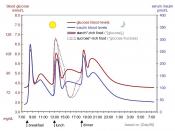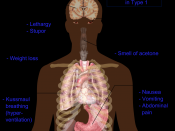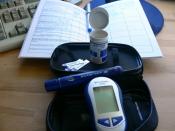WHAT CAUSES IT?
Diabetes is a disease in which the pancreas produces little or no insulin, a hormone that helps the body's tissues absorb glucose so it can be used as a source of energy. The condition may also develop if muscle and fat cells respond poorly to insulin. In people with diabetes, glucose levels build up in the blood and urine. Diabetes mellitus differs from the less common Diabetes insipidus, which is caused by lack of the hormone vasopressin that controls the amount of urine secreted. In Diabetes mellitus, without an appropriate level of insulin to help absorption glucose builds up in the blood because it cannot enter the cells. When the blood passes through the kidneys, organs that remove blood impurities, the kidneys cannot absorb all of the excess glucose. This excess glucose spills into the urine, accompanied by water and electrolytes (ions required by cells to regulate the electric charge and flow of water molecules across the cell membrane) this causes frequent urination to get rid of the additional water drawn into the urine; this triggers excessive thirst to replace lost water and hunger to replace the glucose lost in urination.
Diabetes is classified into two types. In Type I, or insulin-dependent Diabetes mellitus (IDDM), formerly called juvenile-onset diabetes, the body does not produce insulin or produces it only in very small quantities. Symptoms usually appear suddenly and in individuals under 20 years of age. Most cases occur before or around puberty. In the United States, about 5 to 10 percent of all diagnosed cases of diabetes, up to 800,000 people, suffer from Type I diabetes. About 30,000 new cases are diagnosed every year.
Type I diabetes is considered an autoimmune disease because the immune system attacks and destroys cells in the pancreas, known as beta cells,


